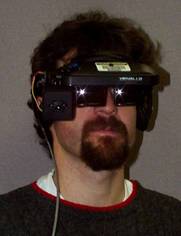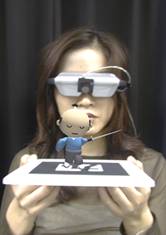| Item | Price |
| Pentium IV 2Ghz | $1000 |
| Hauppauge WinTV capture card | $50 |
| Marshall Board CCD Camera | $250 |
| Sony Glastron PLM-A35 | $400 |
| VGA to NTSC converter | $100 |
| Total Cost | ~ US$1950 |
In this page we introduce some of the hardware usable with ARToolKit.
Camera
The most efficient solution keep a video capture card with a PAL or NTSC camera that offers a large choice and a really good quality camera (but a PAL camera can be really expensive according its characteristics). The signal deliver is RGB image (color palette) that reduce hardware or software palette conversion cost.
The traditional choice is USB or Firewire camera. You can notice that frame-rate or color palette (RGB, YUV, YUV compressed) depend mainly on the bandwidth of the technology. USB Camera used generally compressed format transmission like YUV:4:2:2 YUV:4:1:1 (lossy compression). Firewire Cameras offers better solution, but camera with full RGB color palette are generally expensive (a compressed format in VGA remains a good choice).
| USB1.1 | max 1.5 MByte/s | most low cost solution. |
| IEEE1394a | 60 Mbyte/s | good solution with a standardized camera protocol. |
| PCI32Bit1.0 (33Mhz) | 125.89 MByte/s | |
| PCI64Bit2.0 (33Mhz) | 251.77 MByte/s | |
| USB2.0 | max 50 MByte/s | badly supported on Linux. |
| IEEE1394b | 100 Mbyte/s | few cameras support this protocol. |
| PCI32Bit2.1 (66Mhz) | 251.77 MByte/s | |
| PCI64Bit2.1 (66Mhz) | 503.54 MByte/s |
And the bandwidth of a video image in function of the palette format, framerate, and image size (SIF is 320x240):
| SIF RGB 15 fps | 27 MBit/s (3.37 MByte/s) |
| SIF RGB 30 fps | 55 MBit/s (6.87 MByte/s) |
| SIF YUV 4:1:1 15 fps | 13 MBit/s (1.62 MByte/s) |
| SIF YUV 4:1:1 30 fps | 27 MBit/s (3.37 MByte/s) |
| VGA RGB 15 fps | 106 MBit/s (13.25 MByte/s) |
| VGA RGB 30 fps | 221 MBit/s (26.37 MByte/s) |
| VGA YUV 4:1:1 15 fps | 53 MBit/s (6.63 MByte/s) |
| VGA YUV 4:1:1 30 fps | 106 MBit/s (13.25 MByte/s) |
New USB 2.0 or IEEE1394b cameras offer a good future choice for developing ARToolKit applications.
Some people have also experimented with wireless camera image transmission.
(lot of measurements come from this webpage )
It is not necessary to have a head mounted display to use the ARToolKit, a camera connected to a computer is the only requirement. Without an HMD ARToolKit applications can be viewed on a computer monitor, with an HMD a more immersive experience can be created.
 Figure 1a: Virtual i-O i-glasses with camera |
 Figure 1b: Olympus EyeTrek with camera |
The ARToolKit programs shown so far have used video see-through augmented reality where the computer graphics are overlaid on video of the real world. Both the i-glasses and EyeTrek support NTSC video input, so a simple way to achieve video see-through AR is to connect the head mounted camera to the computer running the ARToolKit application, display the AR application on-screen and then use a VGA-NTSC converter to convert the monitor output to a signal that can be displayed back in the HMDs. The SGI O2 computer has NTSC input and output so these HMDs can be connected directly to the computer without the need for a converter.
ARToolKit also supports optical see-through augmented reality. In this case an optical see-through HMD is used and only the virtual images are shown in the HMD. Since the HMD is see-through the effect is that the virtual images are overlaid directly on the real world. The i-glasses are semi-transparent and so can be used for optical see-through AR, however the EyeTrek displays are fully occlusive.
There are advantages and disadvantages of optical versus video see-through AR. Optical see-through AR allows you to see virtual objects stereoscopically, rather than with bioccular viewing as with a single camera video see-through system. The real world is also perceived at the resolution of the eyes rather than the resolution of the display. The main drawback with optical see-through AR is the lag in the system. In a video see-through application the video frame of the real world that is shown in the HMD is the same video frame that is used to calculate the head position and orientation so the virtual image will appear exactly overlaid on the real world scene. This is achieved by not showing the video frame until the image processing is completed. However in an optical see-through application the view of the real world cannot be delayed, so the delay introduced into the system by the graphics and image processing is perceived by the user. This results in virtual images that may not appear attached to the real objects they are supposed to be registered with, or that "swim" around. These lag effects are particularly noticeable with rapid head motions or moving the object the virtual image is supposed to be attached to.
For a full discussion of the advantages and disadvantages of optical and video see-through AR, please see Ron Azuma's Siggraph 95 course notes on Augmented Reality.
To finish, we provide you with a short list of HMD solutions. A lot of interesting low-cost HMD product have been discontinued these last years, the market being too small to sell enough of this technology (like the famous Sony Glasstron). You can find a lot of second-hand products at VR resellers or on specific forums.
Optical See-Through HMD
Video See-Through HMD
Standard HMD (for build-it-yourself See-Through HMD)